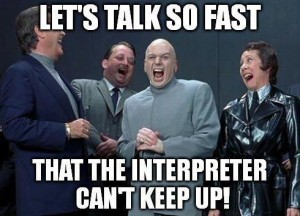Legal interpreters are taught to keep an emotional distance with the witness to guarantee the witness complete access to the judicial process, as if they spoke fluent English. It also benefits the interpreter to have a sole focus on the linguistic components of the statement while monitoring the content. Certified interpreters are bound by our Code of Professional Responsibility to not show any emotion or bias in reaction to the statements we are interpreting. In order to do this we have to remain oblivious to the base problem between the parties.
Sometimes maintaining distance can protect us too. By virtue of being a party to a lawsuit, some witnesses are facing a very difficult phase of their lives. No matter if they are the plaintiff or the defendant. The setting exposes the interpreter to a witness whose perception of the difficulty can range anywhere from an inconvenience to a life changing crisis.
For example, in a civil matter where a business agreement was not honored, the party will suffer compromise of the investment of time and money. A personal injury affects one party’s physical and emotional life yet may affect the financial life of the other. Family law and criminal cases easily display a strain on either party and often it is on both parties.
The interpreter can’t predict aggressive questioning or know how a witness will react to a probing Q&A process. Establishing the distance at the start of the proceeding is a good safeguard. In my introductory spiel I include that I have nothing to do with the case and that my work is regulated by state law. Not making eye contact reinforces the distance. Most outbursts in a courtroom are quickly diffused by the Judge. But that is not the case in other discovery proceedings.
I’ve had a 6’7 Stevedore pick me up by my shoulders and yell in my face, angry at the pointed question I very accurately interpreted. I’ve had several witnesses dissolve into tears in my lap when reminded of the loss of a loved one. I’ve seen witnesses curse and yell at everyone in the room. I’ve seen a witness knock over the videographer’s camera. One angry witness hit the court reporter’s steno machine to stop writing what he said. The most memorable was a divorce mediation and the wife announced she was a witch, whereupon she went around the table putting a curse on everyone. When she got around to me, I reminded her I would have to interpret the curse and it would fall back on her. I was spared.
Interpreters need to understand the lawyer’s obligations to their client. Lawyers are trained to evaluate their client’s personality so they can best represent them. Lawyers can assess their client’s responsiveness patterns during deposition and trial preparation. But we interpreters need to be prepared for outbursts from the start of our career. We also need to be comfortable knowing that in such an eruption that we can and should reference the event as an impediment to our performance. We can ask for a break. And we can address the issue with the attorney. We can protect ourselves and our good work.


